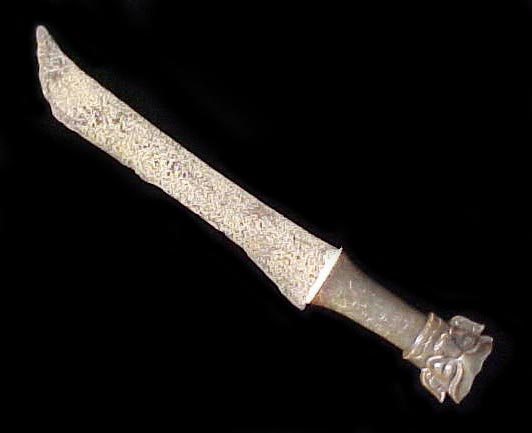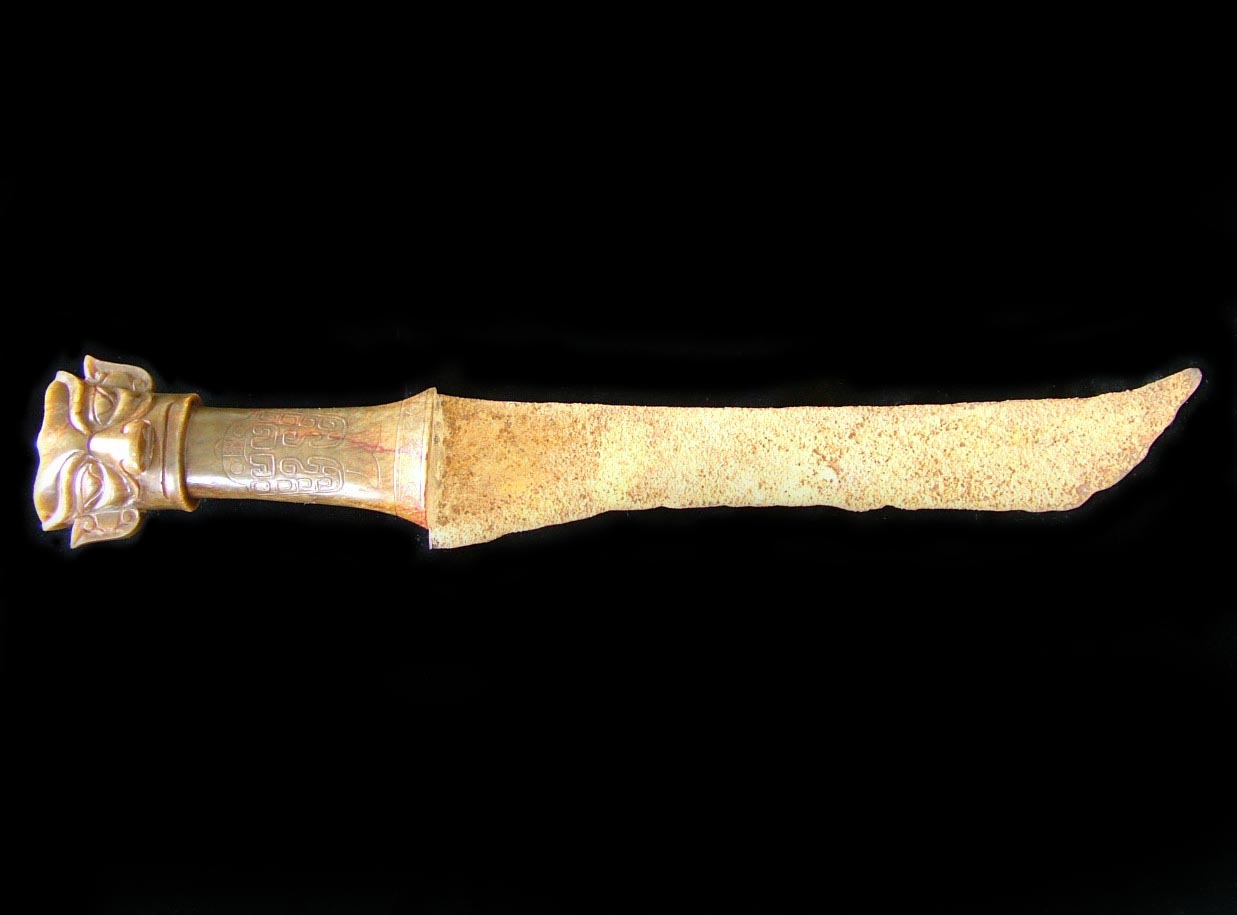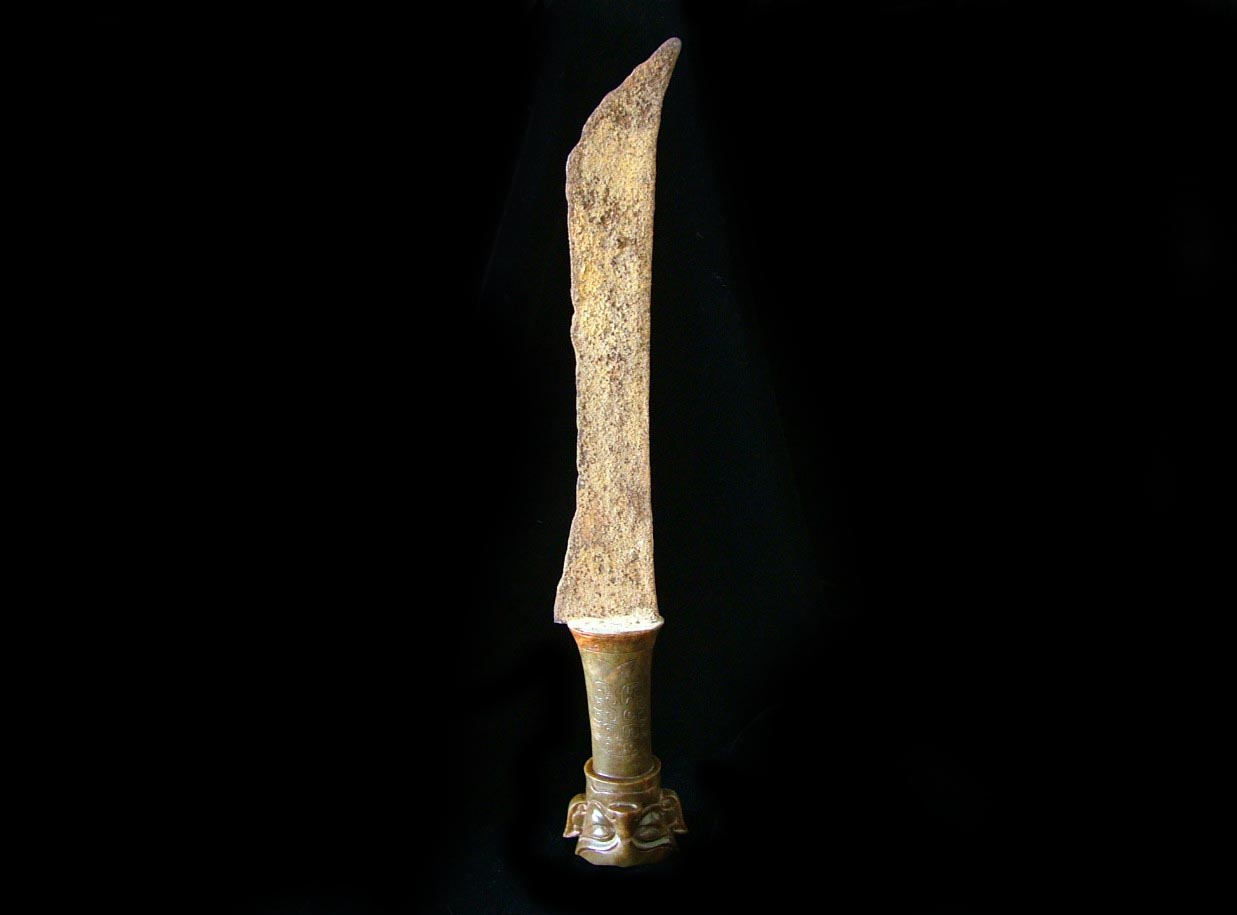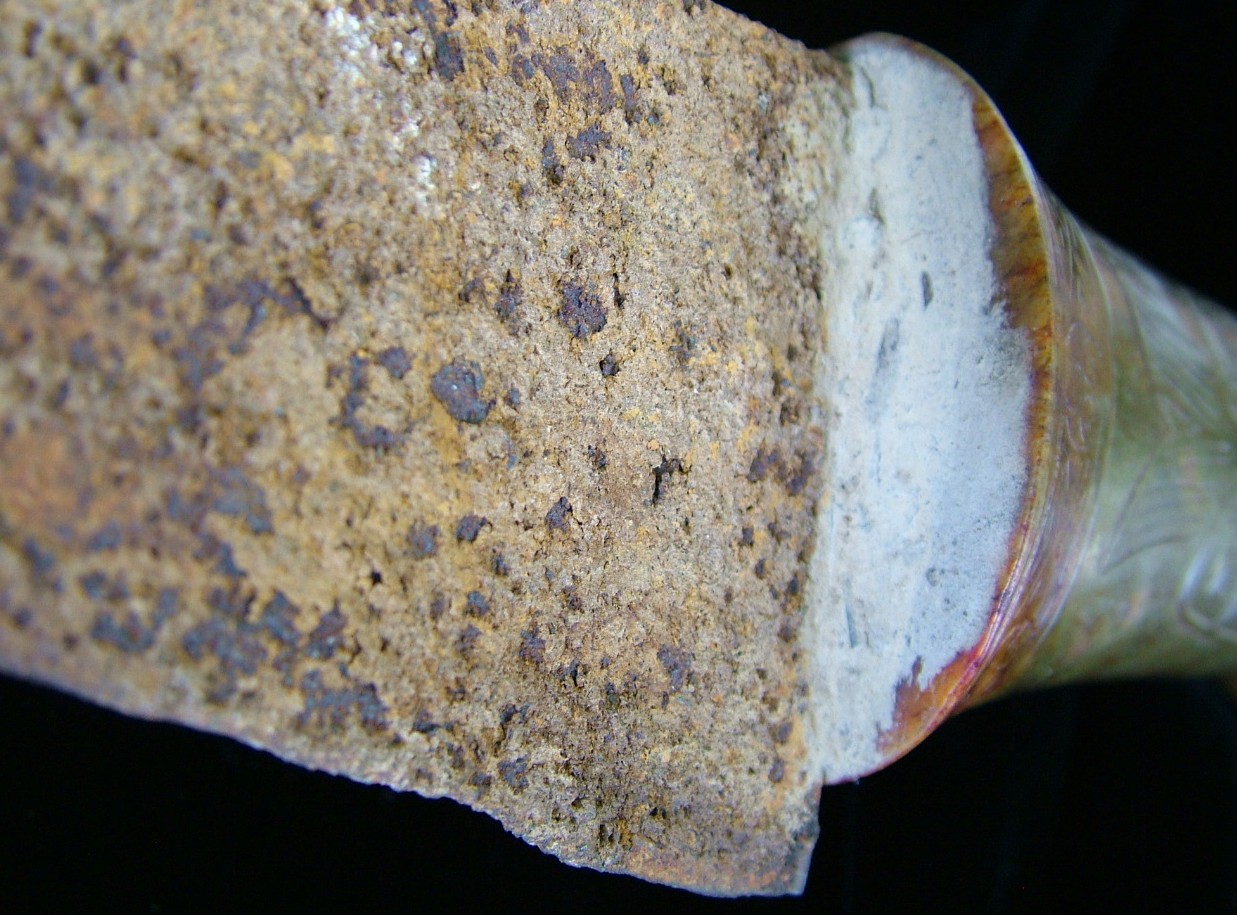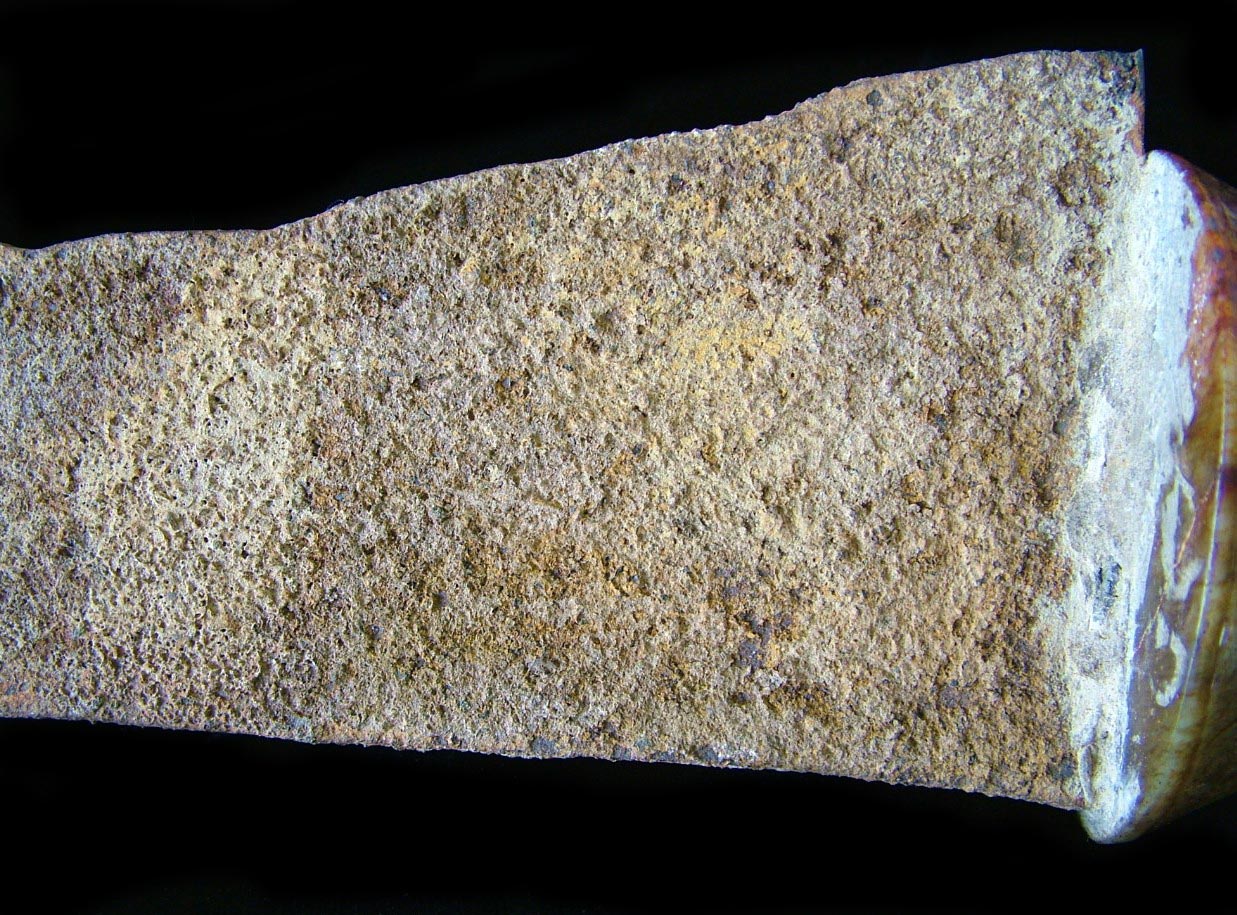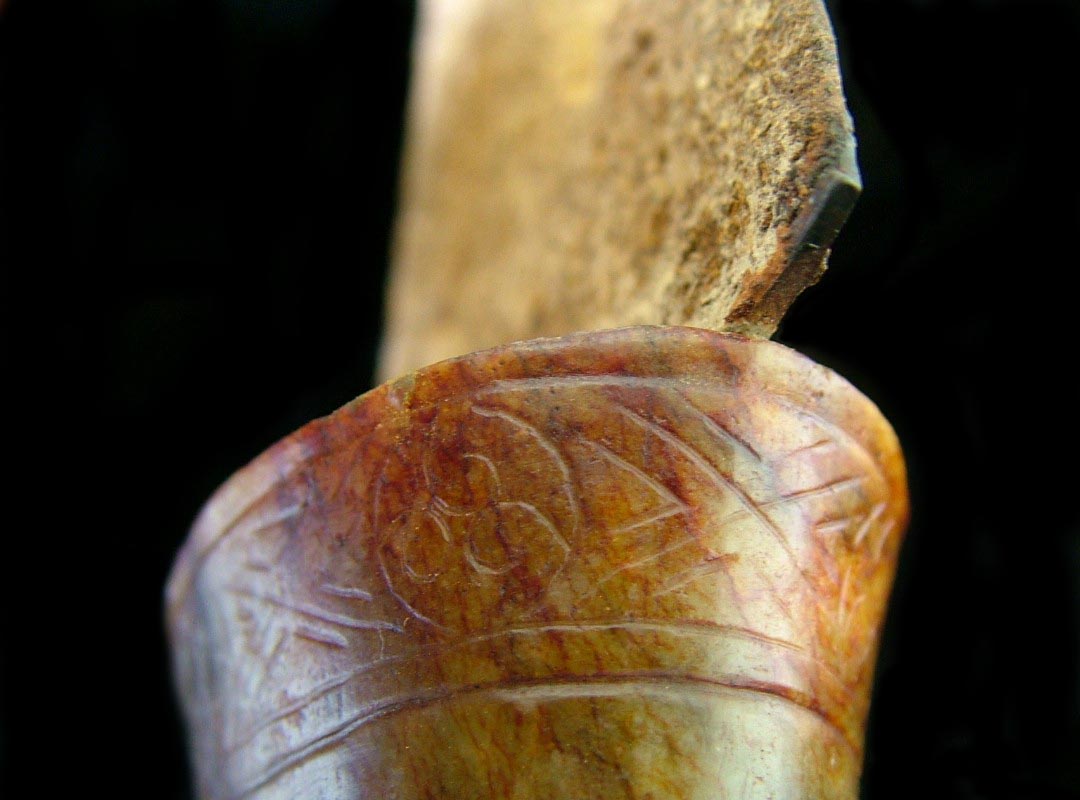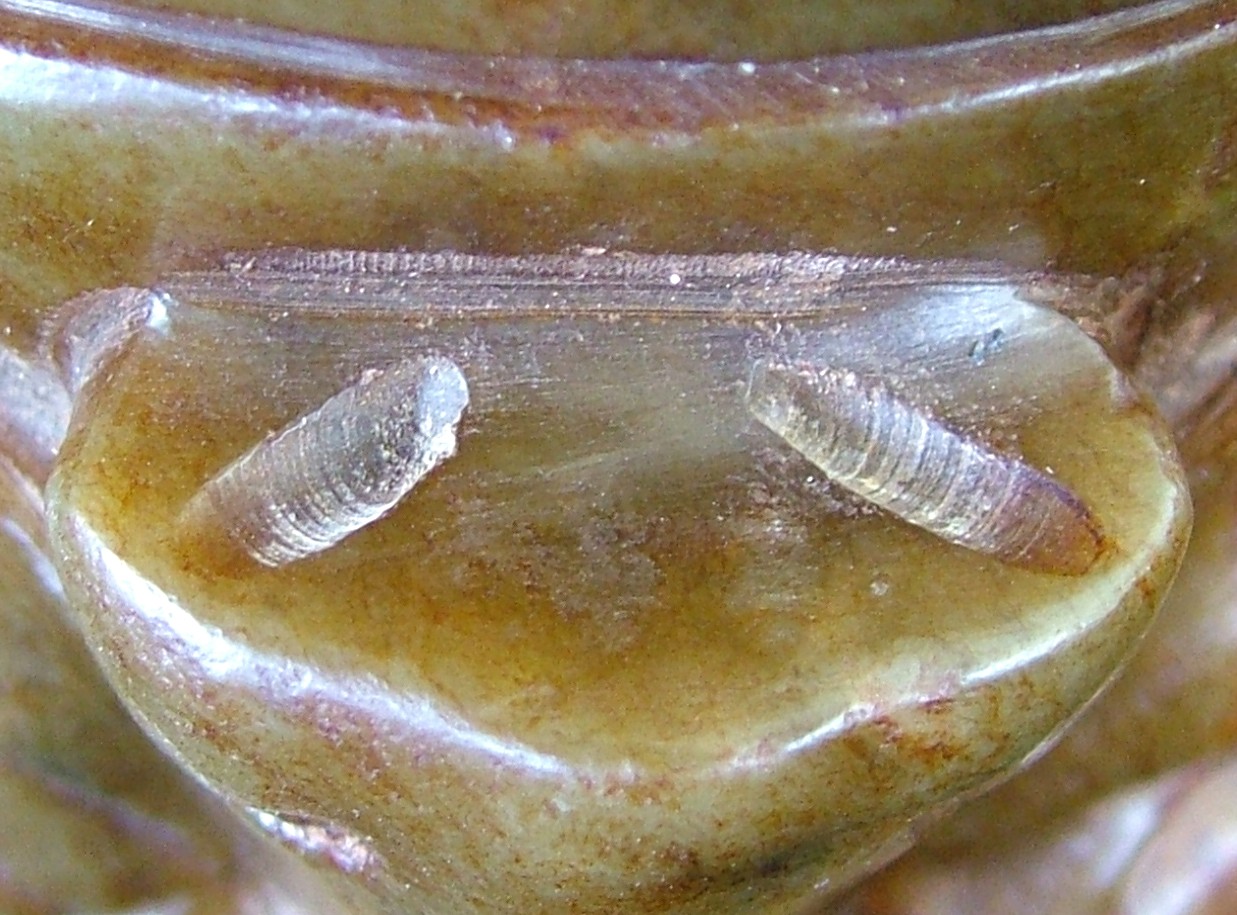 |
|---|
WARRING STATES SANXINGDUI SWORD |
|
| Warring States Sanxingdui Dao Sword |
|
| This is a jade hilted iron Warring States Ritual Sanxingdui Sword. It is listed with preliminary information published in 2006 on kingarthurbanner.com. It has since been thoroughly researched. The new information reveals that it is a shaman's blood sword. It is also a moving sword, meaning that it was designed to move from side to side when lightly tapped. It is of both the north and south, but is particularly of the mythical Kun Peng or Kunpeng (a great fish " the Kun" in the north that when there is a storm transforms into a great bird "the Peng" and flies south), coming from the south. The blade contains symbols that connect it to a legendary killer whale/wolf knife, a Raven (and possibly a raven and a fish) Shaman, a great boat, and a great bird (the Kun Peng). Besides the Sanxingdui association, my research shows that it is now verified as being connected to a tribal people on the Asian North Eastern Pacific coast. It very much suggests that the stories of those people influenced the Sanxingdui, or that they were northern foreigners that were the original Sanxingdui. The Kun Peng myth may have originated with these people, it may even be connected as to how they arrived in ancient China. The information concerning the identification of the weapon as a blood sword and a moving sword is as follows: A sharp cutting nib on a small knife inserted on the ricasso of the blade appears to be designed to cut the crease of the first index finger digit of the right hand (the sword was made for someone right handed), thus drawing the blood of the shaman as he grasped the hilt, but it may also be symbolic of the taking off of a digit, this theme is seen on artifacts with a paw missing, this is usually of a bear connected to a meteor theme, although it is on another continent, it is also seen with a missing hand or arm of the Saxon sword/war god Saxnot and the later Viking god of justice Tyr. If one places the sword on its pommel on a smooth surface (with the blade's tip facing the holder), with a very slight tap the sword will move slightly and mechanically from side to side for precisely 45 seconds, as the blade's tip is pointed at the face it may be that this motion represents the transfer of energy of some kind. The basic idea of this motion can be seen somewhat with Pictures 2 thru 4 with the Title 3 Picture Group. This green jade and iron sword was purchased from a jade collector in California. It was guaranteed to have been brought out of Inner Mongolia in 1946. It was described as a Warring Kings Meteorite San Xing Dui (aka Sanxingdui)* Sword of the Xiongnu Empire (403 to 221 BC). It was also attributed to be a magical protector weapon from the Maodun's plundered jade treasure trove. The Maodun was a Yuezhi (the Yuezhi were an eastern Scythian type people) who became the ruler of the Xiongnu Empire and then conquered his own people. These attributions may or may not be so. I have no way of verifying the origin of the sword, but the dealer /collector is reputable and an expert in ancient Asian jade and metal objects. As for the claim that it is of meteorite metal, an ancient weapons expert explained that without melting down of a portion of the iron there is no way to verify if the metal is or has meteorite metal. With that said, there is symbolism that very much suggests that there is at least some meteorite metal in the sword's blade; so in my opinion it does contain at least some metal from a meteorite. The Sanxingdui art on this object, which is typical of 1,200 BC, was probably copied based on a Xiongnu knowledge of the Sanxingdui. Dating this from the Xiongnu Empire was done based on the jade and metal analysis of the collector/dealer; the motifs are definitely in the Sanxingdui style. The hilt and blade are 52-1/2 cms long. The jade hilt had been polished (possibly by handling) prior to acquisition. The blade itself is 35-1/2 cms long, it has baked terracotta and, or paste with engravings, there is some yellow and orange paint (these colors may suggest that is also a flaming or solar sword). This chopping sword type is known as a dao, and is thought to be the first Chinese sword type. This first group of pictures shows the sword, the hilt's Sanxingdui head pommel is shaped like a head on both sides, but turned with the pommel down it shows what may be a Fish Hawk's head (Osprey) on each end, a Lotus pommel top, a Cicada Fish on the hilt, on the portion of the hilt that is similar to a guard there are 12 motifs of two designs that alternate. One design has an X motif and the other has three circular swirls that form a circle; from a distance the three swirling patterns themselves look like circles. The Sanxingdui head may be of a Shaman although others often refer to this style as a Sanxingdui Knight. What may be a fish hawk head "may" represent a thunder bird, but as the fish hawk can also be seen clutching a fish, it may also have something to do with the Kun Peng. The lotus is known to the Chinese as a sign of regeneration and good luck; it is called a sea rose. The cicada to the Chinese is a traditional symbol of regeneration, The motif of the three coiled circles and "X" motif on the hilt/guard may have something to do with the Chinese legend/myth of "The Magical Swords" and the three heads, in my opinion it is a mark of a specific sword or blade smith guild. Note that to the right on the guard hilt there is a reddish tint with the jade (and also a few figures), this is where the cut index finger would have gripped the sword hilt, it is distinctly darker then any other discoloration, it may very well be from the iron of ancient blood residue. Amazingly, there is a good balance to this ritual or ceremonial weapon for up and down movement. This balance is centered within the jade hilt, interestingly this is where the X's and swirl motif is placed * The mysterious Sanxingdui in Sichuan Province were an ancient people who were only discovered in the last century. This was the capital of the kingdom of Shu and is in an area known by the local people as the "three star mounds". Could this be the burial place of "The Three Kings" of the Magical Swords story" If so then the three star mounds could symbolize the handle of the Big Dipper or the stars of the Belt of Orion, the three heads may or may not be part of this symbolism. Although the initial discovery for the Sanxingdui was in the 1920's, verification for this culture came in 1986 and with great fanfare. The dates of this culture are still debated but speculations are that the Sanxingdui rose in the 13th C. BC and mysteriously disappeared in the 3rd or 2nd C. BC. The Sanxingdui left no written language and there is no mention of these people in ancient records. There are many questions about these people, but none so much as what their style of art represents about their beliefs. There are bronzes of different types, but the most interesting sculptures look the way the jade handle on this sword does. Some of the bronze works are masks that were mounted on poles; some are partially in hammered gold. There was even a suggestion by Chinese news writers that the Sanxingdui may have originated from aliens, this was due to a purported UFO sighting by locals near the excavation at the three star mounds, each to his own with this suggestion, but I think that it is an intriguing fun story. |
|
| Boat |
|
| This group of pictures shows the sword in various positions with the blade's edge on the bottom. The blade can be seen as a boat or the prow of a boat or a ship, there are various figures and faces, at least some of this appears to be of a fishing scene. |
|
| Moving Sword, Flying Bird, Raven, and Raven Shaman |
|
| This group of pictures shows the sword in various positions with the blade's edge on the top. In some of these pictures the blade can now be seen as a flying bird with various figures on it. Pictures 2,3, and 4 give an idea as to it being a moving sword. Pictures 30 thru 34 show a raven and what may be a fish. Pictures 37 thru 41 show a Raven Shaman, with Picture 41 the shaman's hat on the top front shows two bird's heads. |
|
| Advanced Metallurgy 1/1 |
|
| This group of pictures shows that the iron blade had been set in the jade with a treated metal (most likely a lead alloy) that was cold set, then coated with what seems to be a powder mixed with resin. Although there is very little detail there appears to be various figures in a scene. |
|
| Advanced Metallurgy 1/2, Fish, Wolf, Seal, and Blood Sword |
|
| This group of pictures shows the other side of the jade hilt and iron blade, once again there appears to be figures and a scene, or scenes. Pictures 13 thru 27 shows the area where the blade will draw blood on the index figure, it is specific. With this Pictures 13 thru 21 on the bottom of the blade it shows a fish with it's mouth open with a harpooner in front. The tail of the fish is a wolf, on the tip of the wolf's nose there is a small round bit of silver metal, this is what does the cutting. Over this has figures in a scene that is better preserved, this is due to the fact that the work is over an iron insert that has almost no corrosion. With Pictures 20 thru 24 the fish tail as a wolf's head has changed to a fish tail that is a seal's head, Pictures 25 thru 27 shows better detail of the scene in the area over this. |
|
| Advanced Metallurgy 1/3, Legendary Flat Top Fishing Knife, and Orca |
|
| This group of pictures shows the knife on the iron insert on the bottom of the blade near the hilt, the knife is on several other layers on the iron insert, the iron on the knife's blade has not tarnished. Pictures 8 thru 10 show that the knife's blade is an Orca (Killer Whale). Although I do not have any speculations as to how the knife connects to an Orca, I have no doubt that it represents a legendary fishing knife. I have seen this symbolism on many artifacts from a broad range of cultures, it is an extremely ancient theme. |
|
| Possible Founding Figures |
|
| This group of pictures focuses on the nostrils on the jade hilt. My speculation with any figures seen on miniature art is that they are of or connected to founding figures. According to various artifacts human and animal nostrils were highly important to the ancients. Among other things there are suggestions that the nostrils may have been associated with heat and creation. Copyright 2009 David Xavier Kenney |
|

